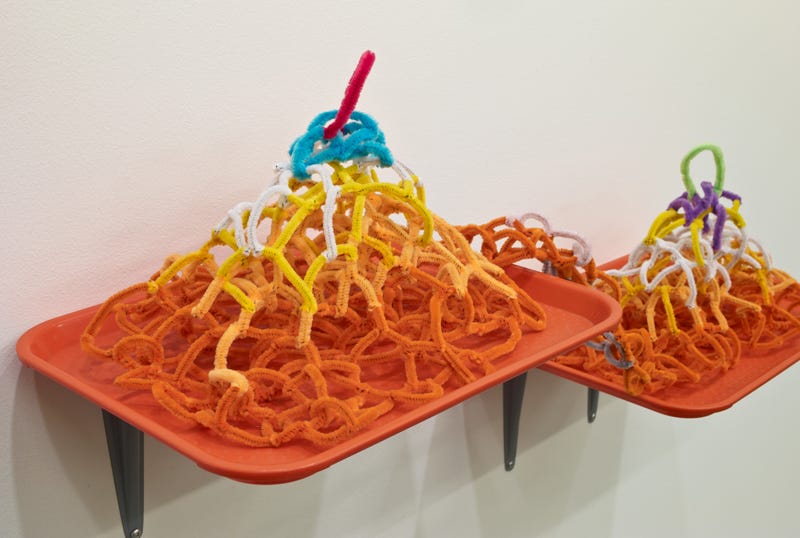The artists in Objects to be Destroyed use unusual materials to create their works of art. They incorporate natural matter or manufactured products directly into their sculptures, assemblages, photographs or video.
Artists, curators and scholars use the phrase “found objects” to refer to non-art materials that are included in artwork. These items are found — or sometimes purchased — by artists, who value them for the way they look or the ideas they inspire. Found objects may simply be placed on a pedestal or wall and treated as works of art, or they can be modified by artists before display. Artists often use found objects in assemblages, which are artworks created by organizing multiple objects into a single composition.
Objects to be Destroyed is full of everyday items, including a clock, an umbrella, a lightbulb and two potholders. Here are five other things to spot in the exhibition:

Food Dye
Tony Feher filled forty-nine glass bottles with water tinted by different proportions of blue food dye for his untitled 2013 work. The color progresses from dark to light and back to dark again six times. Feher compared this progression to the nuanced hues in the sky and ocean. The pulsating blue, he observed, resembles a rolling wave — the form energy takes as it travels through air or water.
Books
Nina Katchadourian was an artist-in-residence at the University of Akron in 2001 when she snuck thirteen stacks of books out of the Akron Art Museum library and placed them behind the reception desk. She arranged the books so the words on their spines formed short poems, stories or aphorisms, many of a humorous nature. These groupings are represented in Objects to be Destroyed by photographs that the artist made as part of a series she titled Akron Stacks.
Rocks
While on a walk in the West Texas desert in 2015, John Newman stumbled upon a small pile of stones. The way the rocks were stacked reminded him of a sitting figure, and their rich hues — including pink, slate gray and tan — caught his eye. Newman scooped up the stones and brought them back to his studio, where he created Tracking and Stacking in Self-Reflection (in Marfa). Inspired by the idea of reliquaries (containers housing holy objects), he crafted a pillow-like form to support the rocks and a dome-like structure with a mirrored interior to reflect them — and closely peering viewers.
Disco Music
For Technology/Transformation: Wonder Woman, a video made in 1978 and 1979, Dara Birnbaum paired footage from the 1970s television series Wonder Woman with the 1978 song Wonder Woman in Discoland. Following Birnbaum’s edited scenes from the TV program, written lyrics to the disco song scroll up the screen as the music plays in the background. These lyrics, including phrases like “Shake thy wonder maker,” highlight the sexualized nature of the show’s presentation of a superhero associated with female empowerment.


Pipe Cleaners
Lucky DeBellevue twists colorful pipe cleaners together into loops, connecting them to build pyramid-shaped structures he displays on top of cafeteria trays. When he first started using pipe cleaners, DeBellevue said he “went with something that was very basic and memorable to me as a child, something I assume others had used in their arts and crafts classes as children or had some other kind of experience with.”
by: Theresa Bembnister, Curator of Exhibitions
Objects to be Destroyed is organized by the Akron Art Museum and supported by funding from the John S. and James L. Knight Foundation and the Ohio Arts Council.

